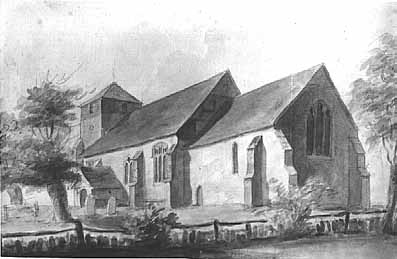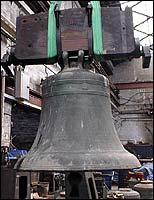

St. Peter's Church, Church Lane, Molash, Canterbury CT4 8HD
The Church of England, Diocese of Canterbury, one of the five churches in the Kings Wood Benefice.
Website: Kings Wood Benefice
From "A Brief Guide to the Church of St. Peter, Molash, Kent" by Alan Neame
INTRODUCTION TO ST. PETER'S CHURCH
The parish church, dedicated to St. Peter, stands half a mile N.W. of the A252, at the end of narrow Church Lane. This contains a number of houses, one of which, Cherry Barton with its walled garden, is extremely old; it ends with handsome half-timbered Church Farm (dated on the woodwork 1624 but surely older) to N. and smaller Old Mill Farm opposite. Apart from these, the position of the church is somewhat isolated but there are signs to S. and S.W. - ancient wells, sherds, a windmill remembered - that this was not always so and that the centre of population has shifted, leaving the church behind.
The church itself is inconspicuous. From most parts of the parish only an informed eye may pick out its unassuming tower among the churchyard yew trees. However, as you enter the village from the W. on the A252, there is a fine view of St. Peter's across the fields
PRE-HISTORY
The church as it stands dates from the early C.13 but there is every reason to suppose there was an earlier church on the site, for the conversion of Kent had been undertaken with great success some six hundred years before the raising of the present structure. True, in an ancient building like St. Peter's, one might expect to find architectural features preserved from a building more ancient still, but in this case, as it happens, there are none discernible above ground. Even so, the yew trees 'of magnificent foliage and girth' that encircle the church were computed in 1880 to be already one thousand years old (A Kentish Garland, 1881, p. 109): four hundred years older, that is to say, than the present building. There are six of them now and used to be a seventh (on the S. side). It is not fanciful to think that, as young trees, they encircled a Saxon church the forerunner of this one.
Then again, the Norman font, which tradition relates to have been found years ago (in fact since 1800) being used as a cattle-trough at Church Farm, is considerably older than the building in which it now stands.

Photograph of watercolour 1807 - Half plate B & W negative
Creator: Petrie, H., F.S.A.
Courtesy and copyright of the Kent Archaeological Society
So, between the Saxon building and the one we see today, there may have been a Norman one as well. But entities are not to be multiplied unnecessarily: the matter could be settled by a controlled dig into the floor and foundations of the church, though this has not been attempted. Equally easily (one might imagine) it could be solved by recourse to Domesday Book. But no! Time out of mind a dependency of Chilham, Molash receives no separate mention in the grand survey, nor is it rated separately in the King's Books.
The name of Molash, variously Molesse, Mollesh, Moldash through the centuries, is derived from OE. mael, speech + aesc, ash, according to Judith Glover (Place Names of Kent, Batsford, 1976) who agrees with J. K. Wallenberg, the Sage of Uppsala. It marks the village as an ancient rural assembly-point where speeches were made and instructive talks delivered under a monumental tree: one day, a royal proclamation as it might be; the next, an eye-witness account of how King Alfred raised the Danish siege of Rochester and sent the heathen packing.
Travellers in Kent must have looked forward to the news service and entertainment available at Molash as they made their way through the deer and boar-infested forest. In, say, 1213 they might have encountered King John in full cry from his hunting lodge at Wytherling Court in the parish. He was locked in negotiations with Archbishop Stephen Langton (Edward Hasted, History of Kent, under Chilham). A day out at Molash with the boar-hounds made a capital change from wrangling in Chilham Castle with the man who first divided the Bible into chapters.
Stained Glass
To see some of the ancient stained glass in the church please click here
Yew trees
Click here for pictures of the 2000 year old yew treesMolash Bell
 This has been recently restored by Taylor Bells and is now in use in the tower.
The single 2ft 10inch bell cast by Joseph Hatch in 1608, has had its cast-in
iron crownstaple removed and replaced by an independent crownstaple with
funding from the Heritage Lottery Fund. The fittings have
been conservatively restored with the bell rehung in the existing timber
frame for swing chiming only.
This has been recently restored by Taylor Bells and is now in use in the tower.
The single 2ft 10inch bell cast by Joseph Hatch in 1608, has had its cast-in
iron crownstaple removed and replaced by an independent crownstaple with
funding from the Heritage Lottery Fund. The fittings have
been conservatively restored with the bell rehung in the existing timber
frame for swing chiming only.
PARISH CHURCH DIRECTORY
VICAR
Reverend Sue Martin 01227 531758
revsuemartin@btinternet.com
Benefice Administrator; Adult protection co-ordinator; Child protection co-ordinator and Disclosure officer:
Dr Jennie Litten-Brown
Email: info@kingswoodbenefice.co.uk
Tel: 07486 889 546
Correspondence Address:
The Vicarage, 3 Hambrook Close, Chilham, Canterbury CT4 8EJ
CHURCH WARDEN
Mr Geoff Jenkins 01233 740 598
P.C.C. SECRETARY
Mrs Clare Hook
Dene
Cottage, Church Lane, Challock TN25 4BS
01233 740 356
TREASURERS
Molash: Mr Paul Brewin
Challock: Mr Roger Spicer 01233 740769